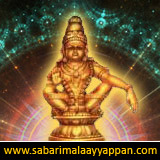Festivities at Guruvayoor Temple
"Om Namo Bhagavathe Vasudevaya"
Ekadasi Festival
Ekadasi, the eleventh day of every lunar fortnight, is very auspicious to the Hindus. Of the 24 Ekadasis in an year, the Vrishchika Ekadasi (Suklapaksha) has got special significance in Guruvayur. It falls in the Mandala season. The Navami (9th day) and Dasami (10th day) are also very important. Ekadasi Vilakku starts a month before the Ekadasi day as offerings by different persons, families and organisations. On Navami day, the Vilakku is lit with ghee as an offering by Kolady family. The Dasami Vilakku which used to be an offering of Zamorin Raja, is now conducted by Guruvayurappan Sankeerthana Trust. After the temple is open on this day for Nirmalya darshan ( 3.00AM ), it is closed only at 9.00 am on Dwadasi Day (12th day), thus allowing continues darshan for devotees throughout Dasami and Ekadasi Days. Until the temple entry for all Hindus in 1947, Avarnas (lower caste) were allowed to come up to Thiyyarambalam on Dasami day (in between Manjulal and Eastern Gopuram). On Dwadasi day there is a custom of offering a token amount called Dwadasi Panam in Koothambalam for the welfare of the family.
A highlight of the Ekadasi is the memorial honour for Gajarajan Kesavan . The Karanavar or head of the elephant family places a wreath at the statue of Kesavan in front of Sreevalsam guest house and all the other elephants stand around and pay obeisance. On Ekadasi day, the Udayasthamana Pooja (continuous pooja) is conducted by the Devaswom itself . After the morning seeveli, on Ekadasi there is a grant elephant procession to the Parthasarathi temple since it is regarded as Geethopadesam Day also. On Ekadasi after night pooja the famous Ekadasi Vilakku with elephant procession takes place and provides a fitting finale to the festival.
Chembai Music Festival
As a part of the Ekadasi fete, an 11-day Chembai music festival is organized, in which an incredible array of some 2000 Carnatic musicians give their best.The renowned musicians of South India participate in this festival. The devotees consider it very auspicious to conduct the arangettam - the debut - on this day in front of the Lord.
Utsavam or Annual Festival
Guruvayur, the Utsavam lasts for ten days. Beginning on the day of Pushya (the 8th asterism) in the month of Kumbham ( February-March), it ends after the Aarattu on the 10th day.Religiously, it is the restoration of divine Chaithanya. Brahmakalasam is preceded by the Utsavam. It is aimed at the purification and energisation of the powers of the deity. It is the last of the long series of rituals of kalasam and at the end, the flag will be hoisted heralding the Utsavam.
Culturally, it consists of various processions, illumination and modest fire-works (this is a specialty of Guruvayur Utsavam that no explosives are used, unlike most of the other Kerala temples). All ten days, the place wears a festive look, streets dressed up with arches, festoons etc., houses freshly thatched and painted. Every shrine and building is tastefully decorated with lights, plantain trunks, bunches of coconut and arecanuts. Two Gopurams and the bahyankana (outer-courtyard) are elaborately decorated with illuminations and eye-catching electric displays. The lamps, deepasthambams and vilakku are all lightened.
Mandala Pooja
Mandala pooja begins on the first day of the Malayalam month of Vrishchikam. This is a period of 41 days for the pilgrimage to the shrine of Lord Ayyappa at Sabarimala. Most of the devotees who go to Sabarimala also visit Guruvayur.
At Guruvayur, there will be special abhishekam with panchagavya (mixture of five products of cow - milk, curd, ghee, urine and cow dung) on all days. Many devotees visit the shrine to partake of it, since it is believed to burn up all inner impurities. Chakkiyar Koothu takes place after lunch. Krishnanattam may be performed after Athazha pooja . Mandalam comes to end with Kalabhaattam (pouring mixture of sandal paste, saffron, camphor and rose water) on the deity. This special offering is made only once in a year and it is the hereditary privilege of the Zamorin Rajas.
Besides, the three seevelis during mandalam will be conducted with three elephants and they take five rounds around the temple. The famous Guruvayur Ekadasi festival, Melpathur statue installation day, Narayaneeyam day and Kuchela day also occur during Mandalam, thus making it the busiest season at Guruvayur. During this season, special arrangements are made for 'kettunira' and 'malayidal' in front of the Sastha shrine inside the temple.
Saraswathy Pooja
Of the 9 days of the Navarathri festival, the last three days are specially sacred for goddess Saraswathy who presides over the world of learning and fine arts. Children are initiated into learning on the last day known as Vidyarambham day. The training in Krishnanattam, Kathakali, Kalaripayattu, (traditional martial art-form of Kerala) etc. generally begins on this day.
Thiruvonam
On the Uthradam day of the month of Chingam (August- September), thousands of devotees bring "Kazhcha kulas" (bunches of Banana) as offering to the Lord. These bananas are given to all the elephants of Guruvayur Devaswom on the same day or next day. On Thiruvonam day, free Onam feast with Pazhaprathaman is given to thousands of devotees.
Ashtami Rohini
Ashtami Rohini in Chingam (August-September) is the birthday of Lord Krishna. Appam and Palpayasam are considered to be important offerings on this day. Special feast is arranged for the devotees.
Nira Puthari
It means new rice. It is a formal beginning of the use of rice from the new harvest season for offering in the temple. Puthari payasam is offered to Lord; it takes place in the month of Chingam.
Vaishakha
The Vaishakha is the lunar month starting from new moon of Medam (April-May). The Vaishakha vratham (fast) is auspicious and sacred to Vishnu. The vratham can be followed in the routine of morning ablutions , feeding the poor, keeping fast, taking prasadams from the offerings to the Lord and participating in the divine discourses. The third day of this month - Akshaya-thrithiya - birth day of Balarama, is the most auspicious. Palpayasam is the main offering and feast is also arranged during the entire Vaishakha month.
Vishu
The first day of Medam ( mid April) is the new year day for Malayalees. People believe that the fortunes for the next year depend on the nature of the objects one sees in the morning of Vishu. For this purpose, Kani (an omen) with articles like yellow flowers, rice, betel nuts, golden coins etc. is displayed in front of the deity. Thousands prefer to see Kani at Guruvayur on Vishu morning. Crowds stay overnight inside the courtyard of temple, which is specially permitted on this day. They close their eyes and set their eyes on the Kani and deity, as the doors are opened at 2.30 am for darshan.
Kucheladinam
The first Wednesday of the month of Dhanu (December) is celebrated as Kuchela Dinam. It is based on the belief that it was on this day that Kuchela, an ardent devotee of Lord Krishna offered Avil (parched rice) to him and in return attained eternal bliss and material property . Avil offering is considered auspicious on this day.
Samkrama
The Samkrama Sandhyas, a very auspicious occasion for worship of the Lord, is observed by the devotees on the eve of each Malayalam month in the spirit of intense devotion and piety. Thousands of people stream in to the temple for a darshan of the Lord at the time of Deeparadhana. Spiritual discourses and various cultural programmes befitting Hindu faith are held at Melpathur Auditorium.




